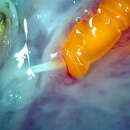en
names in breadcrumbs


Pomphorhynchus is a genus of parasitic worms belonging to the family Pomphorhynchidae.[1]
The species of this genus are found in Europe and Northern America.[1]
Species:[1]
Pomphorhynchus is a genus of parasitic worms belonging to the family Pomphorhynchidae.
The species of this genus are found in Europe and Northern America.
Species:
Pomphorhynchus bosniacus Kistaroly & Cankovic, 1969 Pomphorhynchus bufonis Fotedar, Duda & Raina, 1970 Pomphorhynchus bulbocolli Linkins, 1919 Pomphorhynchus bullocki Gupta and Lata, 1968 Pomphorhynchus cylindrica Wang and Gu, 1983 Pomphorhynchus dubious Kaw, 1941 Pomphorhynchus francoisae Golvan, 1969 Pomphorhynchus jammuensis Fotedar and Dhar, 1977 Pomphorhynchus kashmirensis Kaw, 1941 Pomphorhynchus kawi Fotedar, Duda and Raina, 1970 Pomphorhynchus kostylewi Petrochenko, 1956 Pomphorhynchus laevis (Zoega in Müller, 1776) P. laevis is a parasitic acanthocephalan worm that can influence the reaction of its intermediate host, the freshwater amphipod Gammarus pulex, to the smell of potential predators like perch, Perca fluviatilis. P. laevis facilitates its movement from its initial host. Research has demonstrated that organisms affected by the parasite exhibit a diminished or inverted avoidance response to the scent of predators when compared to uninfested specimens, supporting the notion that the parasite manipulates its host, with the goal of passing itself on to its definitive host, a freshwater fish. Affected specimens also demonstrate vibrant changes in color, making them more visible to predators. This worm swells its proboscis to press microneedles into the intestinal wall, with a very strong adhesive force. This has inspired a structural skin graft adhesive that sticks strongly but has minimal tissue damage while in place and upon removal. Pomphorhynchus lucyi Williams & Rogers, 1984 Pomphorhynchus megacanthus Fotedar and Dhar, 1977 Pomphorhynchus moyanoi Olmes and Habit, 2007 Pomphorhynchus omarsegundoi Arredondo and Gil de Pertierra, 2010 Pomphorhynchus oreini Fotedar and Dhar, 1977 Pomphorhynchus orientalis Fotedar and Dhar, 1977 Pomphorhynchus patagonicus Ortubay, Ubeda, Semenas and Kennedy, 1991 Pomphorhynchus perforator (von Linstow, 1908) Pomphorhynchus purhepechus García-Varela, Mendoza-Garfias, Choudhury & Pérez-Ponce de León, 2017 Pomphorhynchus rocci Cordonnier & Ward, 1967 Pomphorhynchus sebastichthydis Yamaguti, 1939 Pomphorhynchus sphaericus Pertierra, Spatz and Doma, 1996 Pomphorhynchus spindletruncatus Amin, Abdullah and Mhaisen, 2003 Pomphorhynchus tereticollis (Rudolphi, 1809) Pomphorhynchus tori Fotedar and Dhar, 1977 Pomphorhynchus yamagutii Schmidt and Higgins, 1973 Pomphorhynchus yunnanensis Wang, 1981 Pomphorhynchus zhoushanensis Li, Chen, Amin & Yang, 2017